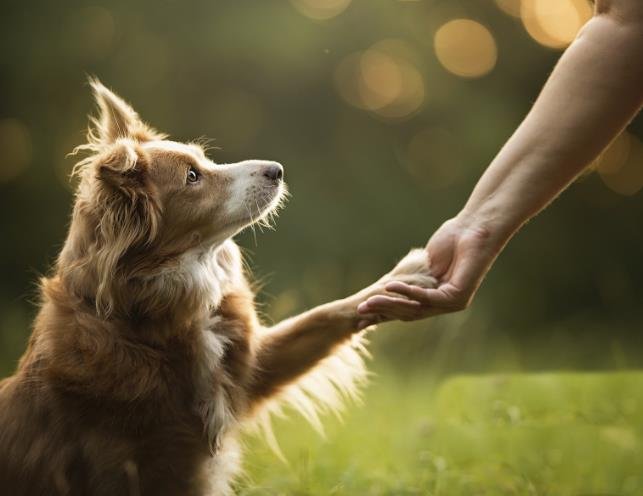
How to Teach Your Dog to Shake Paws: A Step-by-Step Guide
Introduction: Why Teach Your Dog to Shake?
Teaching your dog to shake paws is not only a fun trick but also a useful command that can strengthen the bond between you and your pet. It’s a simple yet impressive gesture that can make your dog more sociable and obedient. In this guide, we’ll walk you through the steps to teach a dog to shake.
Step 1: Prepare Treats and Create a Positive Environment
Before you begin, gather some of your dog’s favorite treats. Positive reinforcement is key in training dogs, and treats will serve as a reward for good behavior. Ensure you are in a quiet environment with minimal distractions; this will help your dog focus solely on you and the training.
Step 2: Get Your Dog’s Attention
Start by getting your dog to sit. Once your dog is in a seated position, hold a treat in your hand and let your dog sniff it. Make sure your dog is paying attention to your hand, as this will be crucial for the next steps.
Step 3: Command and Gesture
With the treat in your hand, extend your hand and say the command “shake” clearly and confidently. Gently lift your dog’s paw with your other hand while still holding the treat in front of them. This action helps your dog associate the gesture with the command.
Step 4: Reward and Repeat
As soon as your dog’s paw is in your hand, reward them with the treat and offer praise. Repeat this process several times during each training session, gradually reducing the assistance you provide in lifting their paw. Consistency is important, so practice this daily until your dog can shake paws on command without any help.
How to teach dogs handshake training
Conclusion: Practice Makes Perfect
Teaching your dog to shake is a rewarding experience that requires patience and consistency. By following these steps and maintaining a positive training environment, your dog will soon master this charming trick. Remember, every dog learns at its own pace, so be patient and enjoy the process!
American Dingo animal behavior Budget Tips canine behavior Canine Care Canine Health DIY pet projects dog behavior Dog Breeds dog care Dog Care Tips dog exercise Dog Food Dog Grooming dog health Dog Measurement dog nutrition dog ownership dog potty area Dog Training Dog Wound Care Family Pets Hunting Dogs lipomas in dogs newborn puppy care obedience training outdoor pet care Pet Care Pet Care Tips Pet Health Pet Loss Pet Safety pet tips pet training Positive Reinforcement Potty Training Puppy Care puppy health Puppy Training Rabies in Dogs Temperature Monitoring Training Tips veterinary advice Veterinary Care Veterinary Tips
-
 Essential Care Guide: Pet dogs Wellness Checks Every Owner Needs
2 views
Essential Care Guide: Pet dogs Wellness Checks Every Owner Needs
2 views -
 Understanding Exercise Needs for Different Dog Breeds
2 views
Understanding Exercise Needs for Different Dog Breeds
2 views -
 2025 Mice-Proof Dog Food Storage: 3 Expert Tips to Block Rodents (+ Garage Storage Hacks)
2 views
2025 Mice-Proof Dog Food Storage: 3 Expert Tips to Block Rodents (+ Garage Storage Hacks)
2 views -
 How to Successfully Potty Train Your Dog in Singapore
1 view
How to Successfully Potty Train Your Dog in Singapore
1 view -
 How to Teach Your Puppy to Sit: A Step-by-Step Guide
1 view
How to Teach Your Puppy to Sit: A Step-by-Step Guide
1 view -
 The Ideal Age to Start Potty Training Your Dog
1 view
The Ideal Age to Start Potty Training Your Dog
1 view -
 Top 10 Famous Dogs in the World The Three Stooges of Sledding and Housebreaking Make the List
1 view
Top 10 Famous Dogs in the World The Three Stooges of Sledding and Housebreaking Make the List
1 view -
 Pitbull Allergies: 7 Vet-Approved Signs, Treatments & How to Protect Your Dog (2025 Guide)
1 view
Pitbull Allergies: 7 Vet-Approved Signs, Treatments & How to Protect Your Dog (2025 Guide)
1 view -
 Mastering the Art of Training a 2-Year-Old Dog: Tips and Tricks
1 view
Mastering the Art of Training a 2-Year-Old Dog: Tips and Tricks
1 view -
 2025 Dog Labor Guide: 4 Vet-Approved Steps for Safe Home Delivery (Emergency Protocols Inside)
1 view
2025 Dog Labor Guide: 4 Vet-Approved Steps for Safe Home Delivery (Emergency Protocols Inside)
1 view










Leave a Reply
You must be logged in to post a comment.